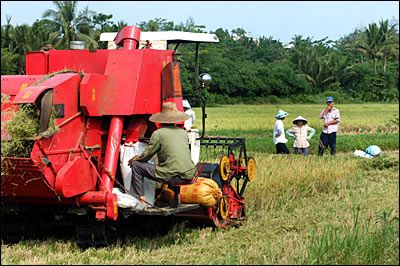| Tools: Save | Print | E-mail | Most Read |
| Cultivated Land Continues to Disappear |
| Adjust font size: |
A shortage of land and water resources is the most significant challenge facing China's agricultural development. Chen Xiwen, a senior rural development official, called in Shanghai Sunday for more efficient measures to prevent further loss of cultivated land. Chen is also vice minister of the Office of the Central Leading Group on Financial and Economic Affairs. He emphasized that in 2003 the per capita cultivated land was 1.43 mu (1 mu equals 1/15 hectare) and the figure had fallen to 1.4 mu in 2005. He indicated that this trend is likely to continue. According to the National Bureau of Statistics (NBS), in 2005 the per capita cultivated land in China was only 40 percent of the world's average level and the per capita water accounted for 27 percent. Chen said that every year local governments apply for a total 12 million mu of land for construction projects, while the central government only allows 4 million mu of cultivated land to be occupied for that purpose. In 1996 the total cultivated land in China was 1.951 billion mu. However, this figure had dropped to just 1.83 billion mu in 2005. In other words, 121 million mu of valuable agricultural land had been lost within a decade. Currently there are just six provinces with cultivated lands surpassing 100 million mu. To some extent, water shortages also obstruct the development of agriculture. Despite the country's per capita water availability of 2,070 cubic meters, there are significant imbalances within different regions. For example, in north China the figure is much lower than this. In Beijing it's only 400 cubic meters and the situation is even worse in Tianjin. China's agricultural distribution has changed, said Chen. Rice planting develops quickly in northeast China, but at the same time water shortages in this region are serious. He suggested that the current utilization of irrigation facilities should be improved. These systems have been installed in 100 million mu of cultivated land but they actually cover 700 million mu or so. If the above problems cannot be resolved properly, the agricultural industry is likely to face a crisis in the near future. According to Chen, in order to promote the development of agriculture, China will have to both encourage domestic demand and bridge the gap between urban and rural areas. The NBS figures show that in 2005 there were 745 million rural residents in China, which is 57 percent of the total population. However, their consumption volume was only 32.9 percent of the whole nation. It was therefore important to promote the rural economy and increase the income of rural residents, Chen said. Chen also felt concerned over the growing gap in public services between urban and rural areas. At present, expenditure on public services in the countryside only takes one fourth of the national average level; thus the government needs to greatly increase investments in this regard, he said.
(China.org.cn by Wang Ke, July 4, 2006) |
| Tools: Save | Print | E-mail | Most Read |
 |
| Related Stories |
| Product Directory China Search |
Country Search Hot Buys |
